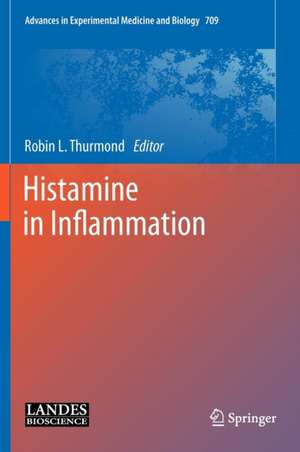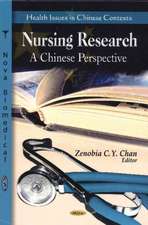Histamine in Inflammation: Advances in Experimental Medicine and Biology, cartea 709
Editat de Robin Thurmonden Limba Engleză Hardback – 16 dec 2010
Din seria Advances in Experimental Medicine and Biology
- 9%
 Preț: 719.60 lei
Preț: 719.60 lei - 20%
 Preț: 691.93 lei
Preț: 691.93 lei - 5%
 Preț: 717.00 lei
Preț: 717.00 lei - 5%
 Preț: 716.28 lei
Preț: 716.28 lei - 5%
 Preț: 717.20 lei
Preț: 717.20 lei - 15%
 Preț: 640.24 lei
Preț: 640.24 lei - 5%
 Preț: 1113.83 lei
Preț: 1113.83 lei - 5%
 Preț: 715.71 lei
Preț: 715.71 lei - 5%
 Preț: 820.43 lei
Preț: 820.43 lei - 15%
 Preț: 641.38 lei
Preț: 641.38 lei - 5%
 Preț: 716.28 lei
Preț: 716.28 lei - 5%
 Preț: 523.99 lei
Preț: 523.99 lei - 5%
 Preț: 1031.00 lei
Preț: 1031.00 lei - 5%
 Preț: 717.00 lei
Preț: 717.00 lei - 5%
 Preț: 715.35 lei
Preț: 715.35 lei - 20%
 Preț: 1161.71 lei
Preț: 1161.71 lei - 5%
 Preț: 1170.51 lei
Preț: 1170.51 lei - 18%
 Preț: 1119.87 lei
Preț: 1119.87 lei - 5%
 Preț: 1288.48 lei
Preț: 1288.48 lei - 5%
 Preț: 1164.67 lei
Preț: 1164.67 lei - 5%
 Preț: 1101.73 lei
Preț: 1101.73 lei - 18%
 Preț: 1123.67 lei
Preț: 1123.67 lei - 5%
 Preț: 1435.64 lei
Preț: 1435.64 lei - 20%
 Preț: 1044.10 lei
Preț: 1044.10 lei - 18%
 Preț: 946.39 lei
Preț: 946.39 lei - 5%
 Preț: 292.57 lei
Preț: 292.57 lei - 18%
 Preț: 957.62 lei
Preț: 957.62 lei - 18%
 Preț: 1235.76 lei
Preț: 1235.76 lei - 5%
 Preț: 1231.55 lei
Preț: 1231.55 lei - 5%
 Preț: 1292.30 lei
Preț: 1292.30 lei - 5%
 Preț: 1102.10 lei
Preț: 1102.10 lei - 18%
 Preț: 1132.81 lei
Preț: 1132.81 lei - 5%
 Preț: 1165.19 lei
Preț: 1165.19 lei - 5%
 Preț: 1418.48 lei
Preț: 1418.48 lei - 5%
 Preț: 1305.63 lei
Preț: 1305.63 lei - 18%
 Preț: 1417.72 lei
Preț: 1417.72 lei - 18%
 Preț: 1412.99 lei
Preț: 1412.99 lei - 24%
 Preț: 806.16 lei
Preț: 806.16 lei - 18%
 Preț: 1243.29 lei
Preț: 1243.29 lei - 5%
 Preț: 1429.44 lei
Preț: 1429.44 lei - 5%
 Preț: 1618.70 lei
Preț: 1618.70 lei - 5%
 Preț: 1305.12 lei
Preț: 1305.12 lei - 18%
 Preț: 1124.92 lei
Preț: 1124.92 lei - 5%
 Preț: 1097.54 lei
Preț: 1097.54 lei - 15%
 Preț: 649.87 lei
Preț: 649.87 lei - 5%
 Preț: 1097.54 lei
Preț: 1097.54 lei - 18%
 Preț: 945.79 lei
Preț: 945.79 lei - 5%
 Preț: 1123.16 lei
Preț: 1123.16 lei
Preț: 1095.73 lei
Preț vechi: 1153.39 lei
-5% Nou
Puncte Express: 1644
Preț estimativ în valută:
209.73€ • 227.89$ • 176.29£
209.73€ • 227.89$ • 176.29£
Carte tipărită la comandă
Livrare economică 21 aprilie-05 mai
Preluare comenzi: 021 569.72.76
Specificații
ISBN-13: 9781441980557
ISBN-10: 1441980555
Pagini: 162
Ilustrații: XVIII, 143 p.
Dimensiuni: 178 x 254 x 15 mm
Greutate: 0.45 kg
Ediția:2010
Editura: Springer Us
Colecția Springer
Seria Advances in Experimental Medicine and Biology
Locul publicării:New York, NY, United States
ISBN-10: 1441980555
Pagini: 162
Ilustrații: XVIII, 143 p.
Dimensiuni: 178 x 254 x 15 mm
Greutate: 0.45 kg
Ediția:2010
Editura: Springer Us
Colecția Springer
Seria Advances in Experimental Medicine and Biology
Locul publicării:New York, NY, United States
Public țintă
ResearchCuprins
One Hundred Years of Histamine Research.- Molecular Pharmacology of the Four Histamine Receptors.- Histamine Synthesis and Lessons Learned from Histidine Decarboxylase Deficient Mice.- Histamine in Allergic Rhinitis.- The Role of Histamine in Ocular Allergy.- The Role of Histamine in Asthma.- Antihistamines in the Treatment of Urticaria.- Histamine and Antihistamines in Atopic Dermatitis.- Histamine, Immune Cells and Autoimmunity.- Histamine in Neurotransmission and Brain Diseases.- Histamine in Normal and Malignant Cell Proliferation.- The Future Antihistamines: Histamine H3 and H4 Receptor Ligands.
Notă biografică
Robin L. Thurmond, PhD is a Compound Development Team Leader with the Clinical Research group at Johnson & Johnson Pharmaceutical Research & Development in La Jolla, California. Prior to that he was a Research Fellow with the Immunology Drug Discovery group at the same site. He received his BA in Chemistry from the University of Virginia and his PhD in Biochemistry from the University of Arizona. Dr. Thurmond studied membrane biophysics at the University of Arizona and worked on the molecular aspects of rhodopsin function during his postdoctoral training at the Massachusetts Institute of Technology with Dr. Gobind Khorana. He began his career with Johnson & Johnson in 1996 at the RW Johnson Pharmaceutical Research Institute in Raritan, New Jersey, and has been with Johnson & Johnson for over 14 years. Dr. Thurmond currently resides in San Diego, California.
Caracteristici
Provides an overview of the pharmacology of the four histamine receptors and describes how histamine is synthesized and the insights derived from mice where this synthesis is disrupted Discusses the important role of histamine in neurotransmission and for the treatment of various neurological disorders Explains the future of antihistamine research and the potential for novel antihistamines targeting the newest members of the histamine receptor family—the H3 and H4 receptors











